How to Prepare for Interviews and Land the Job
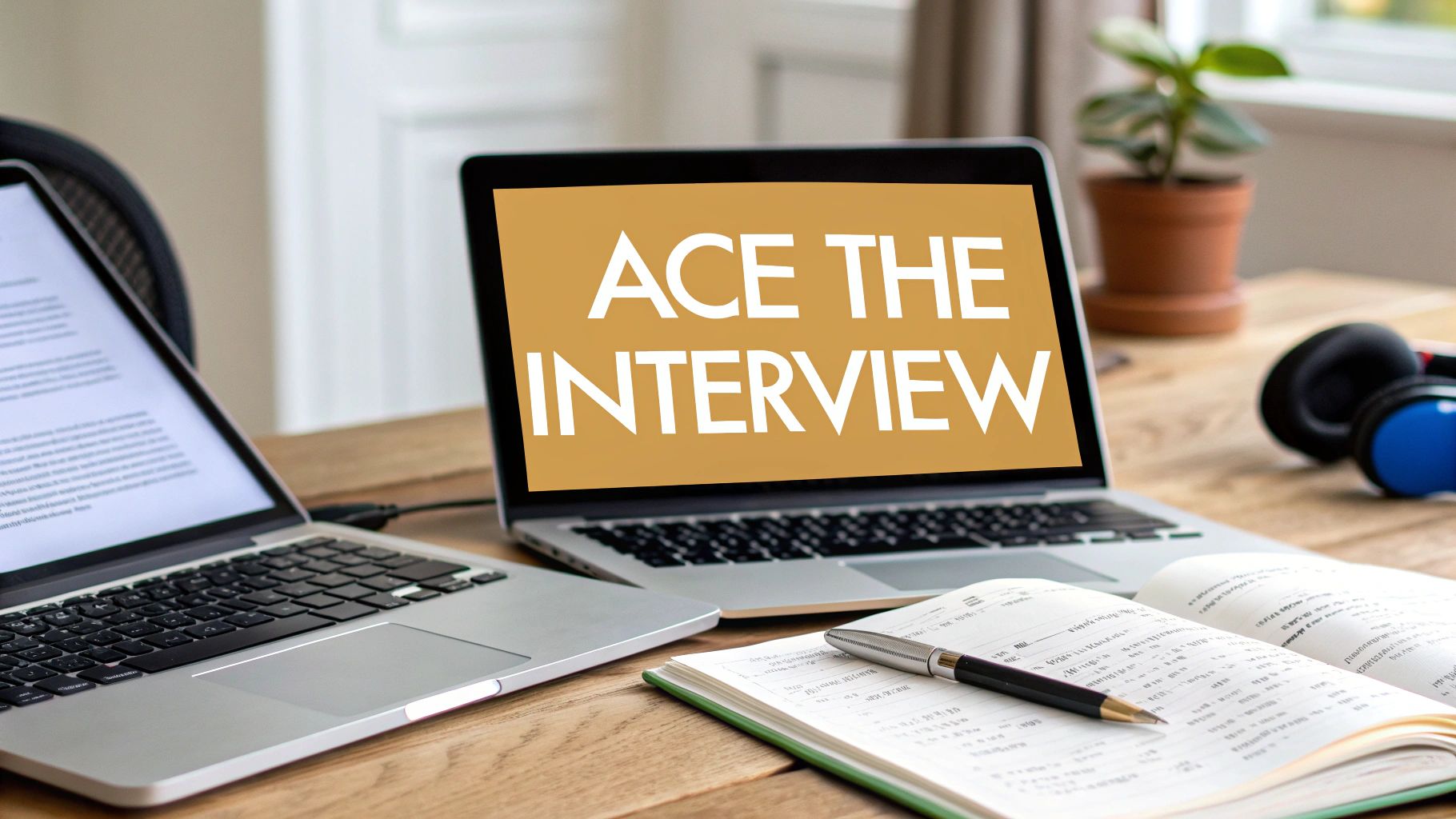
Securing a job offer isn't about memorizing answers. It’s a mix of strategic research, confident storytelling, and practical rehearsal. Answering questions is just one part of the equation; the real goal is to walk in and present yourself as the undeniable solution to that company’s needs. This guide is your modern blueprint for getting there, helping you build genuine confidence that shines through.
Your Interview Preparation Game Plan
Getting the interview is a massive first step, but this is where the real work kicks in. Gone are the days when a quick resume glance-over would cut it. The job market today is competitive, and you need a thoughtful, multi-stage game plan to stand out.
Think of it less like a single event and more like a campaign—one designed to prove your unique value. This means digging deeper than the surface and crafting answers that show you haven't just read the job description, but you truly understand what the company is trying to achieve.
Building Your Case, Step by Step
To get there, you need a clear plan of attack. I've broken down the entire process into logical phases, with each one building on the last. The end goal? You walk into that interview room (or log into that video call) feeling completely prepared and self-assured.
Here's a quick look at the roadmap we'll follow:
- Deep-Dive Research: We’ll go way beyond the company's "About Us" page to uncover what really makes them tick.
- Resume Storytelling: This is about creating a "story bank" of your biggest wins and practicing how to tell those stories effectively using frameworks like the STAR method.
- AI-Enhanced Practice: You'll learn how to use smart tools to sharpen your answers, get instant, objective feedback, and get comfortable with the pressure of a real interview.
- Day-Of Execution: We'll cover everything from managing the logistics to asking smart questions and sending a follow-up that leaves a lasting impression.
This infographic lays out the crucial first steps of the research phase, showing how to move from a general overview to specific details you can use in conversation.
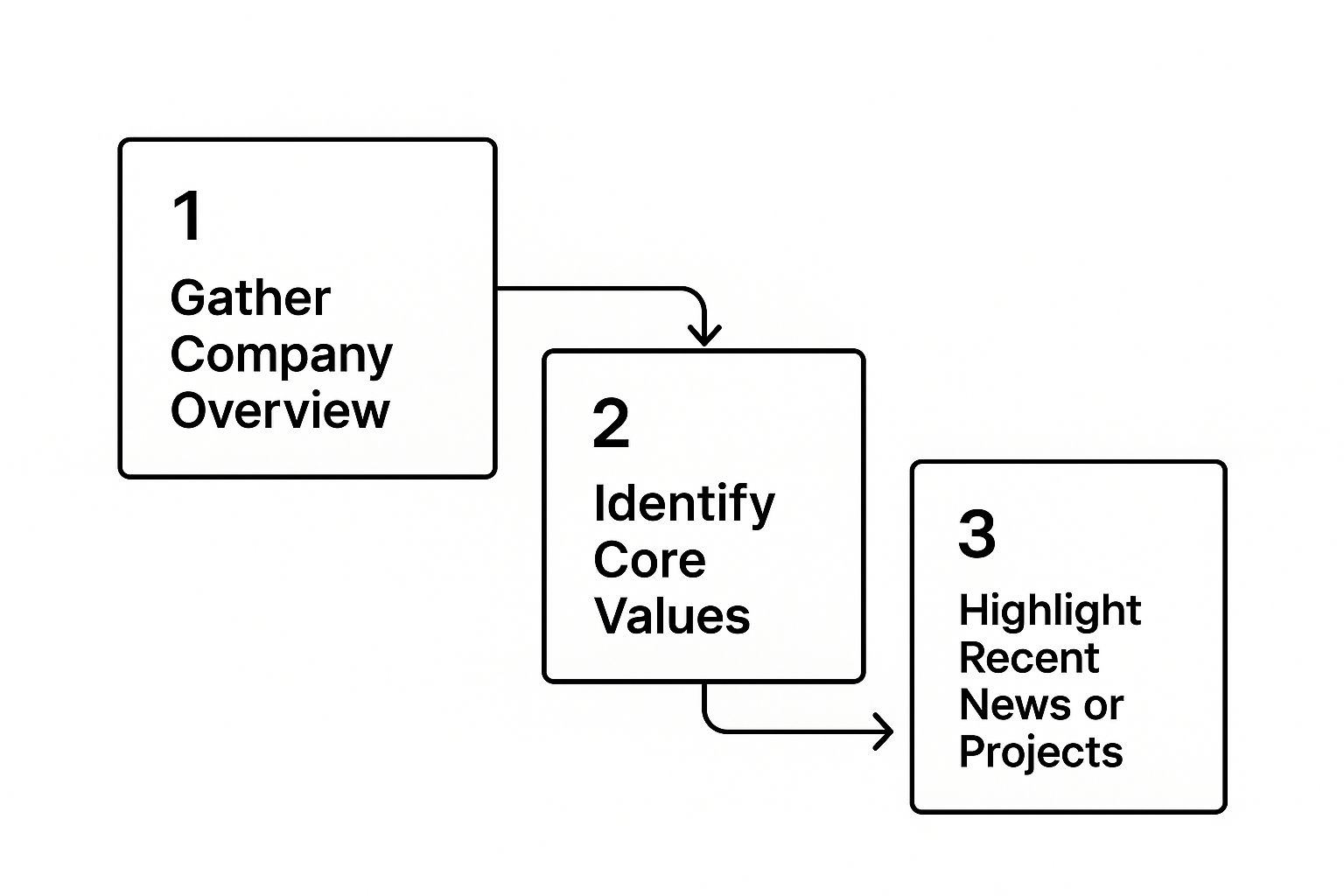
The image really highlights the right way to approach your homework: start broad to understand the business, then zero in on the timely details that will make your answers feel relevant and insightful.
To give you a clearer picture of the journey ahead, this table summarizes the entire preparation process we'll be covering.
Your Interview Preparation Roadmap At A Glance
| Preparation Phase | Key Objective | Time Commitment |
|---|---|---|
| Initial Research | Understand the company's mission, culture, and recent challenges. | 2-3 hours |
| Resume & Story Review | Align your experience with the job role; prepare key success stories. | 3-4 hours |
| Mock Interviews | Practice articulating your value and handling tough questions under pressure. | 2-3 hours (per mock) |
| AI-Powered Practice | Use tools like ParakeetAI to refine delivery and get instant feedback. | 1-2 hours |
| Post-Interview Follow-Up | Solidify your impression and keep the conversation going. | 30 minutes |
Following this structured approach will help you stay organized and ensure no stone is left unturned.
The goal isn't just to know about the company. It's to understand their world so deeply that your answers naturally connect with their goals. Real confidence doesn't come from a script; it comes from this level of deep-seated preparation.
By sticking to this game plan, you’ll shift from simply reacting to questions to proactively demonstrating your value, making sure you’re ready for anything they throw your way.
Lay the Groundwork with Smart Research
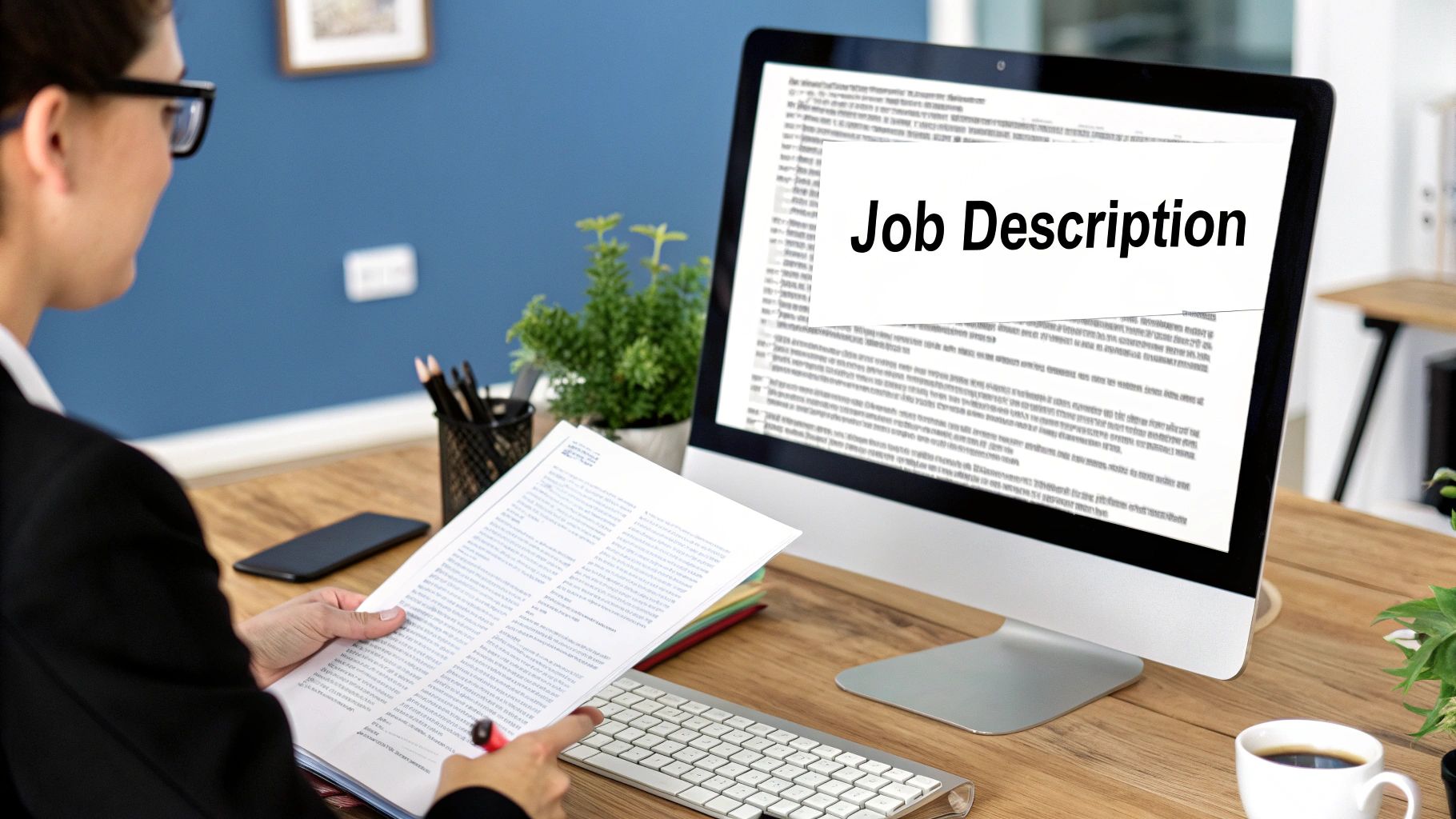
A standout interview performance doesn't just happen. It’s built on a solid foundation of prep work that starts long before you ever join the video call. This isn’t about just knowing what a company does; it’s about genuinely understanding their world so you can position yourself as the obvious solution to their problems.
The job market is no joke. The average opening attracts 118 applicants, but only about 20% of them will even land an interview. Think about that. By the time you’re talking to a recruiter, you’ve already beaten the odds. From that point on, your goal is to turn that interview into an offer, and it all starts with research.
Go Way Beyond the "About Us" Page
If your research consists of a quick scan of the company’s homepage, you’re not doing enough. The real goal is to gather intel that lets you speak with genuine insight about their business, their current challenges, and the opportunities they're chasing.
Here’s where I recommend you start digging:
- Recent Company News: Look for press releases, news articles, or blog posts from the last six months. Did they launch a new product? Enter a new market? Secure funding? These are perfect, timely talking points.
- Industry Trends: Get a feel for the bigger picture. Is the industry growing, or is it facing headwinds? Are there new technologies or regulations shaking things up? This shows you think strategically, not just about the role.
- Leadership and Culture: Find the key leaders on LinkedIn. What are they talking about? Read their mission and values page—these aren't just corporate fluff; they are hiring filters. Mentioning a value that resonates with you can be a surprisingly powerful move.
- A Quick Competitor Analysis: Take a few minutes to check out their main competitors. Knowing who they are and what makes this company different shows you have a sophisticated understanding of where they sit in the market.
This level of homework arms you to ask smarter questions and frame your experience in a way that directly addresses their current reality. It proves you're not just looking for any job—you’re specifically interested in this one.
Decode the Job Description
That job description is your cheat sheet. It’s not just a list of duties; it’s a detailed outline of the company's pain points and the exact skills they think will solve them. Your job is to read between the lines.
Print it out or copy it into a doc and get your highlighter ready. Zero in on the core responsibilities and qualifications. Look for keywords that pop up over and over—those are almost always the most critical parts of the role. For instance, if "data analysis" or "client relationships" shows up three times, you know exactly where to focus your stories.
Every bullet point in a job description represents a problem the company needs to solve. Your job is to connect your past accomplishments directly to those problems, showing you're the solution they've been looking for.
Align Your Story with Their Needs
Once your research is done and you’ve picked apart the job description, it’s time to connect the dots to your own experience. This isn’t about making things up. It’s about strategically framing your achievements to hit on what the interviewer cares about most.
Instead of trying to memorize canned answers, I always tell people to create a "story bank." Start by listing your proudest career moments—the projects, challenges, and results that best showcase what you can do.
Think about times when you:
- Increased efficiency or saved the company money
- Led a team through a tough project
- Solved a thorny technical problem
- Improved customer satisfaction scores
- Learned a new skill to overcome an obstacle
Now, map those stories back to the key requirements from the job description. If they need someone with "excellent time management," pull out a story about how you balanced your work with continuing education.
You could say, "To manage both, I had to be incredibly organized. I lived by a detailed calendar to track deadlines, which helped me finish key projects ahead of schedule and free up study time for my exams."
This approach ensures you're not just answering questions—you're proactively demonstrating your value. You shift the conversation from a generic Q&A to a compelling showcase of what you bring to the table. And that’s how you win interviews.
Sharpen Your Skills with Practice and Rehearsal
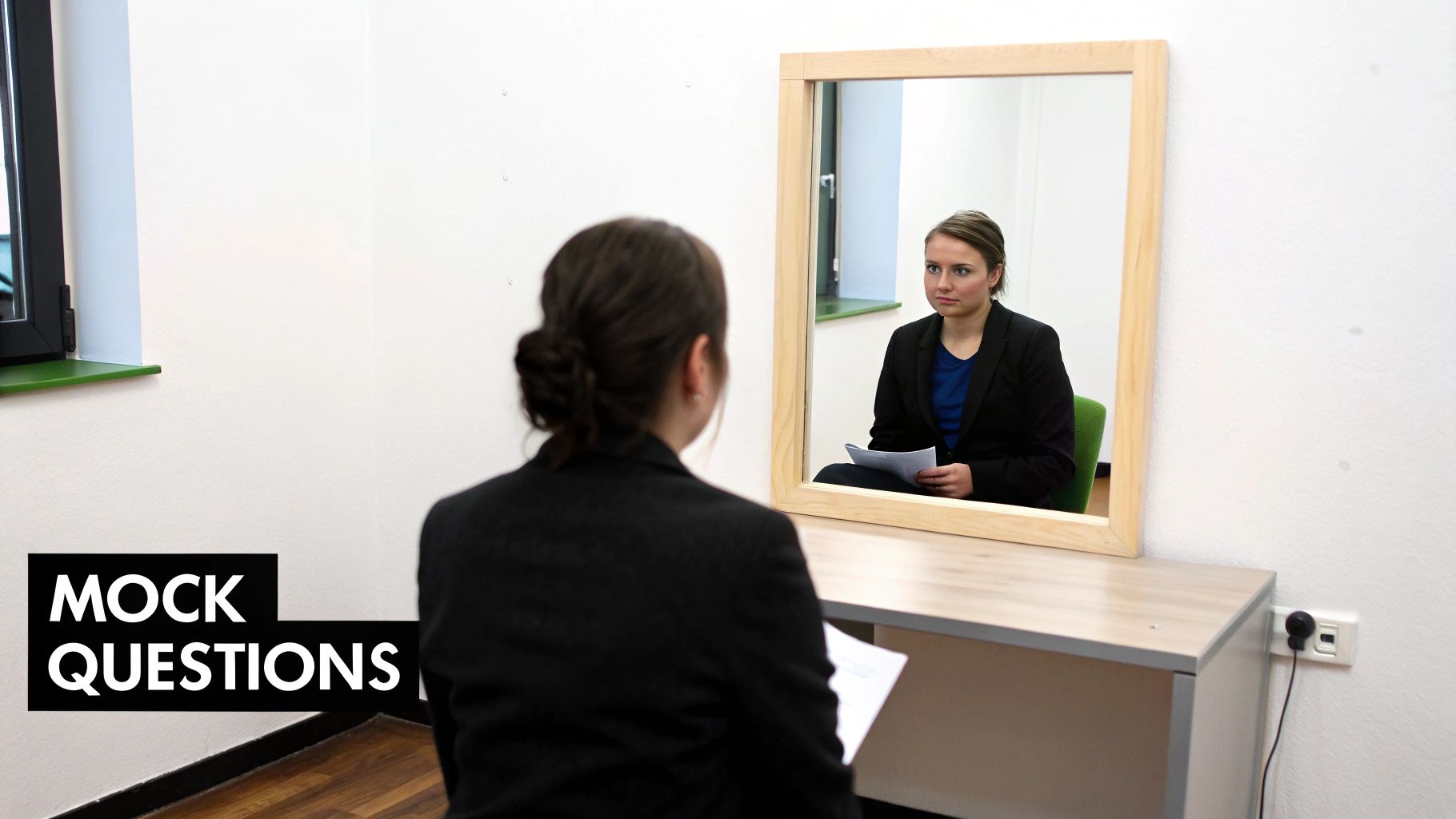
Knowing your career highlights is one thing. Being able to talk about them with confidence and clarity when you’re under pressure? That's a different game entirely.
This is where smart practice comes in. It’s the bridge that takes you from being a good candidate on paper to a memorable one in person. The goal isn't to sound like a robot reciting a script; it’s to internalize your best stories so you can tell them naturally, no matter what question comes your way.
Think of it as building muscle memory for your talking points. When you’ve already practiced explaining your biggest wins, you won’t stumble over the details or forget the incredible results you drove. All that nervous energy transforms into focused, confident communication.
Build Your Story Bank with the STAR Method
Hiring managers love behavioral questions—the classic "Tell me about a time when..." prompts. They use them because past behavior is one of the best predictors of future performance. To ace these, your best tool is the STAR method. It's the gold standard for a reason.
It gives you a simple but powerful framework to tell a story that’s clear, compelling, and focused on results.
- S - Situation: Quickly set the scene. What was the project or challenge?
- T - Task: What was your specific goal or responsibility in that situation?
- A - Action: This is the heart of your story. What specific steps did you take?
- R - Result: What happened? Put a number on it whenever you can. Think revenue, time saved, or efficiency gained.
Instead of getting overwhelmed trying to prep for a hundred different questions, focus on building a "story bank" of your five to seven proudest career moments. Outline each one using the STAR format, and you'll have a flexible arsenal of examples you can adapt to almost any question they throw at you.
Here’s a look at how this plays out for some of the most common questions you're likely to face.
Common Behavioral Questions And How To Structure Your Answers
This table breaks down how you can apply the STAR method to craft strong, memorable answers for frequently asked behavioral questions.
| Behavioral Question | Focus Skill | STAR Method Application |
|---|---|---|
| Tell me about a time you handled a conflict with a coworker. | Conflict Resolution | S: Describe the disagreement. T: Your goal was to find a solution. A: Explain how you initiated a conversation and found common ground. R: What was the positive outcome for the team? |
| Describe a situation where you had to learn a new skill quickly. | Adaptability | S: What was the new technology or process? T: Your task was to get up to speed by a deadline. A: Detail the steps you took to learn (courses, asking experts). R: How did you apply the new skill successfully? |
| Give an example of a time you failed. What did you learn? | Resilience & Growth | S: Briefly explain the project that didn't go as planned. T: What was the original goal? A: Be honest about the misstep and what you did to try and fix it. R: Focus on the lesson learned and how you've used it since. |
| Tell me about a time you went above and beyond. | Initiative | S: What was the standard expectation? T: What opportunity did you see to do more? A: Describe the extra steps you took. R: What was the added value or impressive result of your extra effort? |
By having these stories ready, you avoid that deer-in-the-headlights moment and can respond with a well-structured, impactful example.
From Theory to Practice: A Real-World Example
Let's imagine the interviewer asks, "Tell me about a time you had to handle a tight deadline."
A weak, forgettable answer sounds like this: "Yeah, we had a really rushed project once, but my team and I worked hard and got it done on time." It’s vague and doesn't tell the interviewer anything about what you actually did.
Now, let's pull a story from your STAR-method bank:
(S) Situation: "In my previous role as a project coordinator, our team was just two weeks away from launching a new client onboarding portal when we discovered a critical bug in the payment integration."
(T) Task: "My job was to coordinate between our development team, who was in a different time zone, and the client stakeholders to get the bug fixed without pushing back the launch date."
(A) Action: "I immediately set up a daily 15-minute sync call with the lead developer to get status updates. I then summarized those updates and sent a clear, concise email to our client each morning. I also created a shared document that tracked every single step of the debugging process, which gave everyone full transparency and cut down on the constant back-and-forth emails."
(R) Result: "This streamlined communication process worked wonders. We resolved the bug 48 hours ahead of schedule. The portal launched without a hitch, and the client specifically praised our proactive handling of the crisis. That goodwill directly helped us secure a follow-up project worth $50,000."
See the difference? It's specific, it highlights your skills, and it ends with a quantifiable, impressive result. That's an answer they'll remember.
Simulate the Real Thing with Mock Interviews
Practicing answers in your head is a decent first step, but it’s not enough. Nothing prepares you for the pressure of a real interview like a live rehearsal.
A mock interview helps you find the weak spots in your stories, get your pacing right, and become comfortable thinking on your feet.
Ask a trusted colleague, a mentor, or even a sharp friend to play the role of the interviewer. Give them the job description and your resume, and have them ask you a mix of behavioral and role-specific questions. If you can, record the session. Watching yourself back might feel a little cringey, but it’s the best way to catch nervous habits, like fidgeting or overusing filler words like "um" and "like."
Afterward, ask for honest, direct feedback. Were your answers clear? Did you sound confident? This feedback is pure gold.
This is especially critical in today's virtual-first world. The average hiring process now stretches 3 to 5 weeks, and it’s often packed with video calls. Since 9 out of 10 companies in major markets rely on video for initial screenings, being comfortable on camera is no longer optional. A mock interview is your chance to test your tech, lighting, and background before it counts. Given that over 60% of candidates report dealing with technical glitches, a dry run is just common sense. To really understand what you're up against, it helps to review some of the latest interview statistics.
Master Your Non-Verbal Communication
How you say something is often just as important as what you say. Your body language and tone of voice broadcast your confidence and engagement levels.
These details matter, whether you’re across a table or a screen.
- For Video Interviews: Make a conscious effort to look directly into the camera lens when you're speaking, not at your own face on the screen. This simple trick creates the feeling of genuine eye contact. Also, sit up straight and lean slightly forward to show you're locked in.
- For In-Person Interviews: It’s about natural eye contact, a firm handshake, and calm, confident posture. Use hand gestures to emphasize your points; it makes you seem more dynamic and passionate about what you're saying.
Your tone should be energetic and conversational—not flat or robotic. Let your personality come through. At the end of the day, companies hire people, not just resumes. Your ability to build a human connection can be the very thing that sets you apart from a stack of equally qualified candidates.
Use AI for Smarter Interview Preparation
https://www.youtube.com/embed/iaQvQv6VuTSY
Let's be real: practicing your interview stories and getting solid feedback is a huge pain. Trying to sync schedules with mentors or friends is tough. This is exactly where technology, specifically AI, can be a game-changer. It's moved past being just a buzzword and is now a genuinely practical tool for anyone who wants to walk into an interview feeling prepared and confident.
Think about it. Instead of waiting for a friend to have a free evening, you can get instant, unbiased feedback on your answers anytime, day or night. AI tools can act as a tireless sparring partner, helping you rehearse your delivery over and over until you sound polished and natural. You can use them to run through a full-length mock interview, giving you a truly efficient and effective way to practice.
Generate Practice Questions That Actually Matter
One of the smartest ways to use AI is to feed it the exact job description you're applying for. This simple step turns a generic tool into your personal hiring manager, generating questions that are incredibly relevant to the role. We're talking way beyond the generic lists you find with a quick Google search.
For instance, you could give it a prompt like this:
"I'm interviewing for a Senior Product Manager role at a SaaS company. Here’s the job description [paste job description here]. Act like the hiring manager and give me 10 tough behavioral questions you’d ask, focusing on collaboration, data-driven decisions, and managing stakeholders."
This single prompt transforms your prep from a guessing game into a targeted training session. You’ll be practicing the questions you're most likely to hear, which is a massive confidence booster.
Get Instant, Unbiased Feedback on Your Delivery
Here's where AI really shines: analyzing your performance in real-time. A tool like ParakeetAI doesn't just listen to your words; it gives you immediate, data-driven feedback on your communication style.
It’s not just about what you say, but how you say it. After you practice an answer, you can get hard data on things like:
- Pacing: Are you rushing through your answers because you're nervous? Or are you speaking too slowly?
- Filler Words: How many times did you lean on crutches like "um," "like," or "you know"?
- Clarity: Was your story easy to follow? Did it have a clear beginning, middle, and end?
This is the kind of brutally honest feedback that’s almost impossible to get from a person, who might be trying to spare your feelings. AI gives you the unvarnished truth you need to actually get better. To see how else you can work smarter, check out how the latest AI powered productivity tools are shaping modern workflows.
Here’s a look at how ParakeetAI can give you an edge during a live interview.
As you can see, the tool can discreetly offer talking points and suggestions, helping you stay on track and deliver strong answers without missing a beat.
Make Company Research Fast and Painless
AI can also work as your personal research assistant, saving you hours. Forget about manually slogging through dense annual reports, press releases, or earnings call transcripts. You can have AI pull out the key insights in seconds.
Let's say you need to get up to speed on a company's recent performance. Try a prompt like this:
"Summarize the main takeaways from [Company Name]'s Q3 2024 earnings call. What were their biggest revenue drivers, and what challenges did the leadership team call out?"
This gets you the high-level knowledge you need to ask smart, informed questions during the interview. It shows you’ve really done your homework and sets you apart from candidates who just gave the company's "About Us" page a quick scan. For more tips on using these kinds of strategies, you might find some useful ideas on the https://blog.parakeet-ai.com/. When you bring AI into your prep, you’re not just practicing—you’re building a smarter, data-driven process that covers all your bases.
Mastering the Interview Day and Beyond
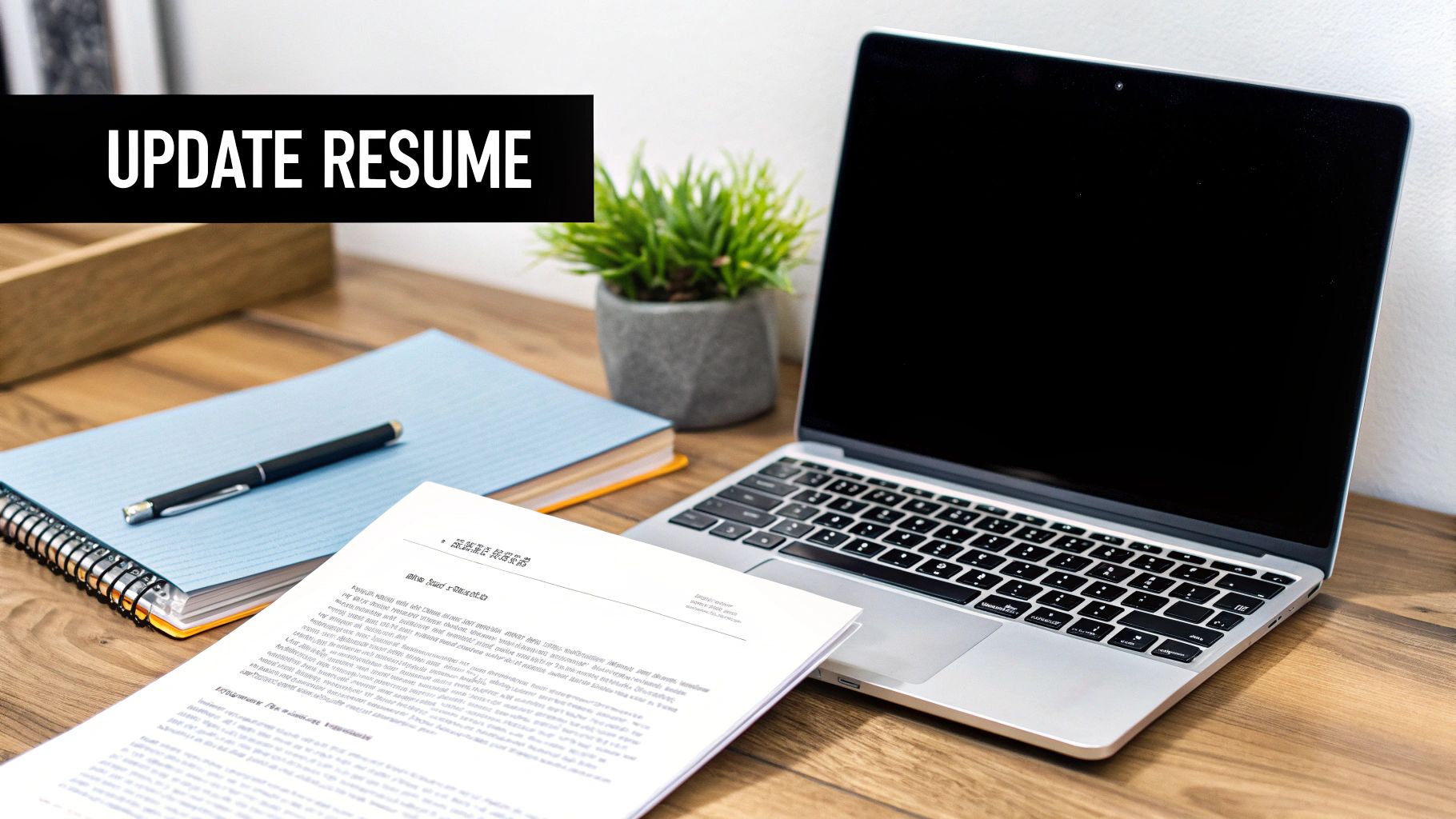
After weeks of prep, the big day is finally here. This is where all that hard work—the research, the mock interviews, the practice—really pays off. It lets you walk in (or log on) with confidence, ready to connect with the interviewer instead of scrambling to remember your talking points.
The key to a successful interview day is to control everything you possibly can. From your tech setup to what you wear, getting the small details right frees up your mental energy to focus on what truly matters: showing them you're the best person for the job.
Setting the Stage for Success
Whether you're meeting in an office or over a video call, your environment speaks volumes before you even say a word. A polished, professional setting shows you respect their time and take the opportunity seriously.
For a video interview, your setup is everything. Think of it as your personal broadcast studio.
- Do a Tech Check: Test your camera, mic, and internet at least an hour before go-time. There's nothing worse for your momentum than a frozen screen or garbled audio.
- Curate Your Background: Find a quiet spot with a clean, uncluttered background. A simple wall or a tidy bookshelf always beats a messy kitchen or a high-traffic hallway.
- Get the Lighting Right: Face a light source, like a window or a lamp. Backlighting will turn you into a silhouette, but good front-facing light makes you look sharp and engaged.
If you’re meeting in person, the logistics are just as critical. Map out your route, budget extra time for traffic, and have a professional portfolio or notebook on hand. If you have to travel, selecting travel-friendly suits for interviews is a smart move to ensure you arrive looking crisp and ready.
Ask Questions That Show You’re a Thinker
Toward the end of the conversation, you'll inevitably hear, "So, do you have any questions for us?" This is your cue. A simple "no" is a huge missed opportunity. This is your final chance to prove you’re a strategic thinker who is genuinely invested in the role.
Skip the basic questions you could find on their "About Us" page. Instead, ask things that show you’re already thinking about how you’ll make an impact.
I always recommend preparing at least three to five thoughtful questions. It shifts the dynamic—you're not just a candidate seeking a job; you're a professional evaluating if this company is the right place for your talents.
Try questions like these:
- "What would a successful first 90 days in this role look like to you?"
- "Could you tell me a bit more about the team I'd be working with and the collaboration style?"
- "What are some of the key challenges this team is focused on right now that I could help with?"
These questions turn the interview from an interrogation into a collaborative discussion. You're no longer just being assessed; you're engaging as a potential colleague, and that’s a powerful way to stand out.
The Art of the Follow-Up
The interview isn't over when you shake hands or end the call. A strategic follow-up email can reinforce your value and keep you at the top of the hiring manager's mind. With today's hiring landscape, this is more important than ever. In fact, 27% of talent acquisition leaders report that adapting their process for hybrid roles is a major challenge, often leading to longer hiring timelines. A good follow-up helps you stay on their radar.
A thank-you note sent within 24 hours is a must.
Here’s a simple formula that has never failed me:
- A Genuine Thank You: Start by thanking the interviewer by name for their time.
- Reiterate Your Interest: Briefly restate your enthusiasm for the position and the company.
- Make a Connection: Reference a specific, interesting part of your conversation. It proves you were listening. Something like, "I especially enjoyed discussing the upcoming product launch..." works perfectly.
- Add One Last Value Prop: Gently remind them why you're a great fit. A quick line like, "I'm confident that my experience with X can directly support the team in achieving Y," is all you need.
This isn’t just about being polite. It’s a final, professional touchpoint that leaves a lasting positive impression. It frames you as a thoughtful, organized, and genuinely engaged candidate—the exact kind of person everyone wants to hire.
Answering Your Biggest Interview Prep Questions
Even the most buttoned-up preparation plan can get derailed by those nagging little questions that create uncertainty. Let's tackle some of the most common concerns that come up when you're figuring out how to get ready for a big interview.
Getting these things straight helps you focus your energy where it actually matters. After all, the goal is to work smarter, not just harder. Knowing the common pitfalls can mean the difference between feeling overwhelmed and walking in ready to shine.
How Many Hours Should I Really Prepare for an Interview?
There’s no magic number here, but a solid rule of thumb is to set aside 5-10 hours of dedicated prep time for an important interview. If you're gunning for a senior or highly technical role, you'll want to lean towards the higher end of that range, or even go beyond it.
The real trick is to break that time down into focused, manageable sessions. Don't try to cram it all into one frantic, coffee-fueled night.
Here’s what a balanced schedule might look like:
- Company Deep Dive (2-3 hours): Go beyond their homepage. Dig into recent press releases, check out their key people on LinkedIn, and get a feel for their market position.
- Crafting Your Stories (3-4 hours): This is where you build out your best career wins using the STAR method. Actually say them out loud until they feel natural.
- Live Practice (1-2 hours): Run through a full mock interview. Grab a friend, a mentor, or use an AI tool to get live feedback.
- Logistics & Final Polish (1 hour): Get your own questions ready, plan your outfit, and double-check all the tech if it's a video call.
The point isn't just to hit a certain number of hours. It's to reach a state of confident internalization, where your best talking points and stories are just second nature—not lines you’ve memorized from a script.
When you structure your time like this, you ensure all your bases are covered without completely burning yourself out.
What's the Single Biggest Mistake People Make?
The most common—and most damaging—mistake is trying to memorize your answers word-for-word. It’s a tempting shortcut when you’re nervous, but it immediately makes you sound stiff and robotic. Worse, you're left completely stranded if the interviewer throws you a curveball or a follow-up question you didn't see coming.
Forget memorization. Focus on internalization. A much better strategy is to build a "story bank."
Think about the 5-7 most impressive accomplishments from your career. For each one, get intimately familiar with the details using the STAR framework. Know the Situation, your specific Task, the Actions you took, and—most importantly—the quantifiable Result.
Once you know these core stories inside and out, you’ll have the flexibility to adapt them to almost any behavioral question that comes your way. You'll sound natural, confident, and genuinely authentic.
How Should I Prepare Differently for a Video Interview?
While the core of your preparation stays the same—your stories, your research—a video interview adds a whole new technical and environmental layer that you have to get right. That screen creates a bit of a barrier, so you have to be much more intentional about how you come across.
Here are the key things to focus on for video calls:
- Your Tech and Environment: This is non-negotiable. Test your camera, mic, and internet connection long before the interview starts. Find a quiet spot with good lighting and a simple, professional background. No one wants to see your laundry pile.
- Mastering "Eye Contact": This is a small trick with a big impact. Train yourself to look directly into the camera lens when you're talking, not at your own face on the screen. To the person on the other end, it feels like you're making direct eye contact.
- Using Notes Strategically: Here's one place video calls give you an edge. You can have a few key bullet points, your resume, or your questions open on your screen (or on a sticky note next to it) for a quick, discreet glance.
Is It Okay to Bring Notes into an Interview?
Yes, absolutely! Bringing a professional-looking notebook with your prepared questions and a few key talking points shows you're organized, engaged, and serious about the opportunity.
For an in-person meeting, just use it for a quick reference—don't read from it like a script. In a video interview, you can keep your notes open on your desktop.
One of the best times to use them is when you get to the "Do you have any questions for us?" part. Referring to your notes to ask a specific, well-thought-out question shows you’ve done your homework and are genuinely interested. Just make sure your notes are a tool, not a crutch that gets in the way of building a real connection.
Ready to walk into your next interview feeling completely prepared? ParakeetAI gives you the practice and real-time feedback you need to master your delivery and ace the toughest questions. Stop guessing and start preparing with a powerful AI assistant. Get started by visiting the ParakeetAI website.




